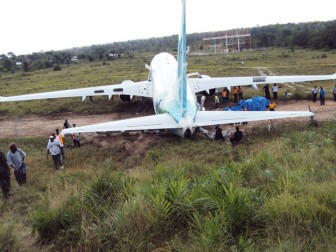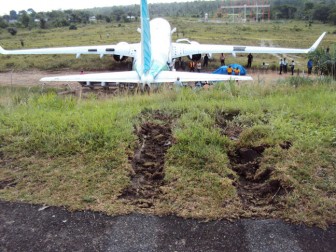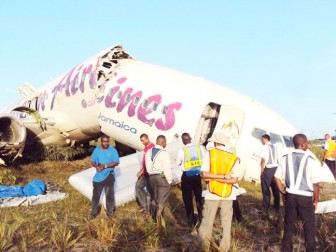As investigators arrive here to probe the Caribbean Airlines (CAL) crash-landing, Fareed Dean, the Trinidadian pilot has reportedly told relatives that poor visibility due to heavy rainfall resulted in the aircraft over-shooting the runway at the Cheddi Jagan International Airport (CJIA).
Dean insisted he did his best to prevent the loss of lives, a relative told the Trinidad Newsday newspaper on Saturday. The 52-year-old pilot was traumatised by the incident and suffered injuries to his legs. Dean reportedly said the runway had poor lighting and this contributed to the poor visibility when he attempted to land at about 1:32 am on Saturday. Dean, his co-pilot and crew members are expected to receive counselling from professional counsellors in the coming days, according to the report.

Director of the Guyana Civil Aviation Authority (GCAA), Zulfikar Mohamed told Stabroek News yesterday that there is nothing wrong with the airport’s lighting system. “It’s all working,” he said. On Saturday, Minister of Transport and Hydraulics, Robeson Benn, responding to questions from reporters, stressed that he is not aware of any deficiencies on the airport runway. Officials here have also said that visibility was good at the time of the crash.
However, they are hesitant to pronounce on what could have caused the incident until investigations are completed. But local investigators are looking at the theory that pilot error might have been the key factor which resulted in the incident, according to an aviation source.
The GCAA is spearheading the investigations into Saturday’s crash and eight investigators from the United States National Transporta-tion Safety Board (NTSB) were expected yesterday. The NTSB team includes experts in operations, meteorology, airworthiness, survival factors, and aircraft performance. Investigators from the Airports Authority of Trinidad and Tobago, the aircraft’s manufacturer – Boeing, CAL, as well as other aviation experts from the Caribbean are expected to be part of the probe.

Meanwhile, an instrument landing system (ILS) – which helps pilots to touch down in low-visibility conditions – is being installed at the CJIA and was not in place when the airliner crash-landed. Mohamed told Stabroek News that the old system was obsolete and a new ILS is being installed. “It is in progress as part of the modernization project,” he said. The old system at the CJIA was decommissioned several years ago, an aviation source said.
“We are hoping that it (the ILS) will be completed at the end of next month but it has to be flight-checked before it can be used,” Mohamed said. The GCAA head explained that it has to be fully tested before it can be put officially into operation.
It has been noted that most large and busy airports have an ILS in place. An ILS is especially helpful when there is low visibility and helps pilots land by giving them a more precise reading of their angle of descent and the position of the aircraft down to 200 feet above the ground. The system at the CJIA is being installed by Canadian company, Intelcan Techno-systems Inc, under a US$3.5 million ($700 million) contract, which will see the upgrading of communication and air-navigation systems at the CJIA.
The contract, signed in August 2009, is the first phase of a project to modernise the airport systems. At the time of the signing, Works Minister Robeson Benn had said that the equipment being used for communications and air navigation systems was 25 to 30 years old. Critics have previously said that the ILS and other upgrades should have been in place a long time ago.

There were 163 passengers and crew onboard the Boeing 737-800 aircraft at the time of the crash. Miraculously, there were no fatalities. The flight originated in New York. The airline, in a statement, said that its CARE policy for affected passengers and crew was deployed in Georgetown. The airline has engaged the services of a company from the United States, together with regional personnel to implement the programme in accordance with this policy, the statement said. A relatives/customer assistance hotline has been established at the airline’s emergency centre in Piarco, Trinidad and counselling is being provided to passengers and family members, the statement said.
In relation to the crash, a source at the airport had told Stabroek News that at around 1:15 am on Saturday, the CAL flight was handed over to air traffic control at the CJIA by Trinidadian authorities and the normal procedures were followed in guiding the aircraft into the airfield. Sometime around 1:20 am, the aircraft commenced its approach procedure for the main 7500 feet runway at the airport. Reports are that around 1.30 am, the aircraft touched the runway surface and within a matter of seconds, disaster followed. The aircraft continued towards the end of the runway and slammed into the side perimeter fence of the airport before breaking in two.
According to the source, there are indications that the pilot may have landed the aircraft a considerable distance beyond the required touchdown zone on the runway for the aircraft type, with speed also playing a key factor. He said the runway surface was also damp as there was rain prior to and during the incident and as such braking action would have been limited to some extent.
Based on passengers’ accounts of what transpired in the final moments of the flight, the pilots may have attempted to commence a missed approach, a procedure in which the navigator ought to raise the aircraft out of the descent mode into the air while in the vicinity of the runway when a successful landing is not possible.
However, a source who visited the scene told Stabroek News that he observed the aircraft engines were already in the “reverse thrust” mode, a position which indicated that massive braking was being attempted by the pilots rather than an attempt to raise the aircraft back into the air. A Boeing pilot also supported this theory.
Runway
The Wall Street Journal reported yesterday that the crash here adds to runway safety worries. It said that investigators are bound to look for possible mechanical problems or pilot mistakes that could have made it difficult to stop the plane.
John Goglia, a former member of the NTSB told the WSJ that “one of the first things investigators will determine is whether the plane was configured properly for landing,” or if any systems failed. The front wing panels, for example, automatically retract during certain kinds of hydraulic failures. The report quoted experts as observing that pictures and preliminary reports suggest that movable panels on the front and top of the plane’s wings, and perhaps also near their rear edges, may not have been extended or failed to operate properly. The devices are designed to help planes decelerate before and after touchdown.
The report said that the crash illustrates the persistent hazards of so-called runway excursions: accidents and serious incidents in which airliners careen off runways, often because pilots landed too fast, touched too far down the strip, or didn’t recognize the difficulty of stopping on wet, slushy or snow-packed surfaces.





